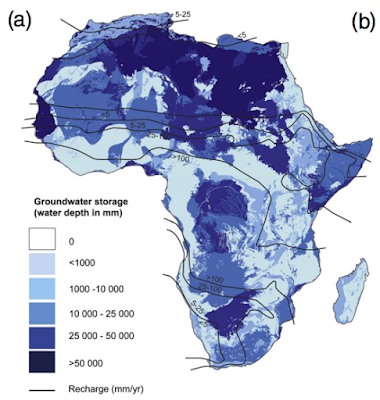The volume of groundwater stored in Africa is estimated to be 0.66million km3, more than 100 times annual renewable freshwater resources, and 20 times the freshwater stored in lakes. This is why groundwater is seen as a potential buffer to climate variability and change.
Let me set the scene of groundwater in Africa. The inconsistency of groundwater distribution is huge; regarding the variability in groundwater storage, recharge, depth and aquifer productiveness.
To illustrate this, MacDonald et al. released a brilliant paper in which they map groundwater resources in Africa. The reason I'm fond of papers such as this is the production of maps means their research can easily be consumed by a wider audience outside of academia, something I myself am hoping to achieve with my blog. If the aim of geographical research is to inform policy change, then the spread of knowledge to inform opinion outside the sphere of academia can have a major impact, and this paper achieves that. Below are three of the maps from MacDonald et al.'s paper.
 | ||
|
 |
| Aquifer productivity for boreholes appropriately drilled and sited using appropriate techniques and expertise. The inset shows the depth to groundwater, from Bonsor and MacDonald. |

So if we have the resource, it's either the technology (which you have answered previously as not an issue in some instances) or is it a political or organisational issue.
ReplyDelete
DeleteWhen countries are not making use of groundwater it can be technology. We have the technology, they may not be able to afford it/have access to it. With the correct measuring and technology groundwater resources can be used sustainably.
In some cases there isn't an issue with using the water, the issue is using too much groundwater and it being inefficient, such as Lusaka, Zambia and Dhaka, Senegal. When there are political/organisational issues with accessing groundwater, it usually involves multiple groups collectively using too much water.
I see in October the IWMI of South Africa had a conference on ground water. A section was titled "From theory to action" and papers presented on the following:
ReplyDelete(i) Mapping irrigation potential from renewable groundwater in Africa – A quantitative hydrological approach; (ii) Estimating groundwater availability at the catchment scale using streamflow recession and instream flow requirements of rivers in South Africa; and (iii) The Ramotswa project – building a joint vision for a shared aquifer.
Does any other country have this capability in Africa. Should we be mapping groundwater availability and country/area capability if we are to really turn "theory into action"
This is a great example of a country trying to take groundwater use and make it sustainable. But it's taken the richest country in Sub-Saharan Africa's richest country until 2015 to start on such a 'Theory to Action' approach. It's fantastic South Africa is doing this, but all of Africa needs to follow to successfully use groundwater!
Delete